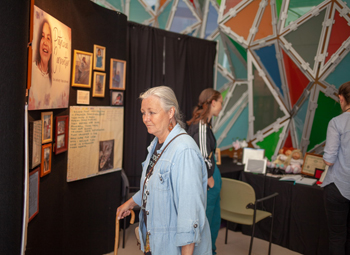Shades of Our Sisters brings conversation, understanding to St. Michael’s

By Amber Daugherty

The Shades of Our Sisters installation highlighted the lives of Missing and Murdered Indigenous Women, Girls, Transgender and Two-spirited People. On National Indigenous Peoples Day, St. Michael’s became the first hospital to host the exhibit.
Patricia Carpenter was a daughter, sister and mother.
Her story is one that’s shared as part of Shades of Our Sisters, an installation that highlights the lives of Missing and Murdered Indigenous Women, Girls, Transgender and Two-spirited People. On National Indigenous Peoples Day, St. Michael’s became the first hospital to host the exhibit.
“We started this as our thesis at Ryerson,” said executive producer Laura Heidenheim. “As media students, we saw there was terrible representation of missing and murdered Indigenous women in the media – lots of victim blaming. We wanted to shift the narrative, so we went to families of the women and asked them and it was their idea to tell the stories about their lives, not their deaths.”
The exhibit features snapshots of lives well lived. Patricia, who was just 14 when she was killed, spent years doting on her younger siblings and had a baby of her own six weeks before she died. Thirty-one-year-old Sonya Cywink was a poet – the installation includes videos of her sister reading some of her work.
“This exhibit is focused on life and celebration – we want people to get to know these women,” said Heidenheim. “Our goal is that people come to understand why they need to think about them as not just statistics but as humans, with families who miss them dearly. They had great potential and I think that’s one thing people walk away with.”
Bringing it to the hospital was a recommendation from St. Michael’s Indigenous, Metis, Inuit and Urban First Peoples Community Advisory Panel. The group is currently creating a work plan to implement calls to action related to health outlined by the Truth and Reconciliation Commission of Canada.
“One of our goals is to look at cultural awareness and safety training, which we’re hoping to bring to all staff across our network,” said Sarah Jayne Kendall, co-ordinator for the panel. “Hosting events like Shades of Our Sisters is important to this because it helps raise awareness of the struggles these patients face and it speaks volumes to the direction we’re moving in to address the needs of all of our patients.”
In addition to the videos, documents and photos displayed at the installation, Patricia’s son, three brothers and mother were also there to talk about their experiences.
“Nobody talked about this when Patricia died in 1992 – there was nothing said about missing and murdered women,” said Joyce Carpenter, Patricia’s mother. “I want people to realize there are more out there – and they’re still going missing every single day. So I’m hoping people will take this away and spread the word about it. I won’t stop talking for her.”
About St. Michael’s Hospital
St. Michael’s Hospital provides compassionate care to all who enter its doors. The hospital also provides outstanding medical education to future health care professionals in more than 29 academic disciplines. Critical care and trauma, heart disease, neurosurgery, diabetes, cancer care, care of the homeless and global health are among the Hospital’s recognized areas of expertise. Through the Keenan Research Centre and the Li Ka Shing International Healthcare Education Centre, which make up the Li Ka Shing Knowledge Institute, research and education at St. Michael’s Hospital are recognized and make an impact around the world. Founded in 1892, the hospital is fully affiliated with the University of Toronto.
